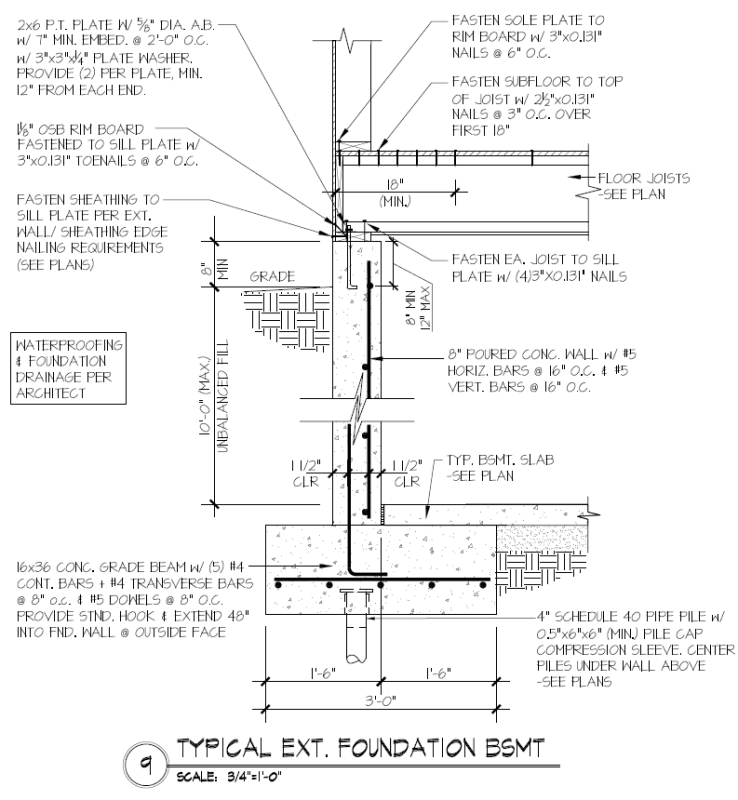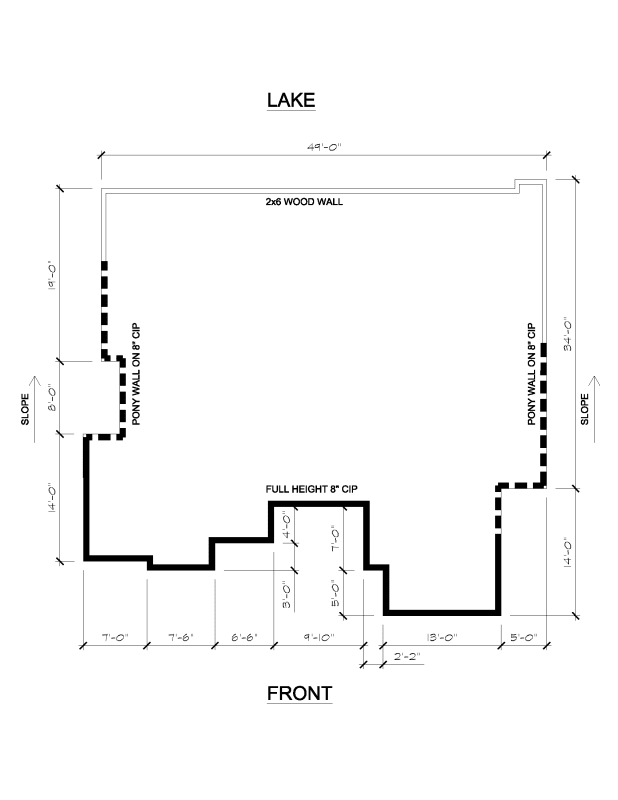Wandering Wallaby
Structural
Hi everyone. I’m working on a 3-story daylight basement residence in SDC D that is adjacent to a lake so the geotech has recommended 4”diameter pin piles down to depths of 60ft.
Typically, I design these basement walls as cantilever CIP walls with the toe of the footing extended out as needed for soil bearing. With pin piles, I will design for a pile under the wall for the axial loads and an additional battered pile towards the toe for the toe pressure and overturning.
However, the owner provided me with the details of the adjacent house on the lot which was recently designed earlier this year by an engineer who eliminated the battered piles by designing the basement wall as a restrained wall and the builder would like to do the same to keep costs down. Even if I could prove the wall could transfer the +/- 580# force through the bolts, sill, joists, and into the diaphragm, I’m concerned that the daylight side of this basement does not have an equal amount of soil for passive resistance. I can probably justify this occurring on the sides of the house where the soil steps down, but not at the front of the house where it is a full height basement with a walk-out patio at the rear of the house. However, this isn’t a straight run at the front of the house; it jogs back and forth following the shape of the house. How do you feel about spanning the basement walls horizontally between the adjacent perpendicular wall segments acting as buttresses/shearwalls and providing a battered pile if needed for the in-plane overturning of those walls?
One last thing, since this is over 6’ of retained soil in SDC D, I typically include the seismic increase using a FS=1 for overturning and sliding (checked against no seismic increase and a FS = 1.5). This seismic force increases the restrained force to roughly 1820# instead of the 580# I quoted above.
Attached is the detail from the owner, as well as the basic perimeter shape of the basement.
Thank you in advance for any responses.


Typically, I design these basement walls as cantilever CIP walls with the toe of the footing extended out as needed for soil bearing. With pin piles, I will design for a pile under the wall for the axial loads and an additional battered pile towards the toe for the toe pressure and overturning.
However, the owner provided me with the details of the adjacent house on the lot which was recently designed earlier this year by an engineer who eliminated the battered piles by designing the basement wall as a restrained wall and the builder would like to do the same to keep costs down. Even if I could prove the wall could transfer the +/- 580# force through the bolts, sill, joists, and into the diaphragm, I’m concerned that the daylight side of this basement does not have an equal amount of soil for passive resistance. I can probably justify this occurring on the sides of the house where the soil steps down, but not at the front of the house where it is a full height basement with a walk-out patio at the rear of the house. However, this isn’t a straight run at the front of the house; it jogs back and forth following the shape of the house. How do you feel about spanning the basement walls horizontally between the adjacent perpendicular wall segments acting as buttresses/shearwalls and providing a battered pile if needed for the in-plane overturning of those walls?
One last thing, since this is over 6’ of retained soil in SDC D, I typically include the seismic increase using a FS=1 for overturning and sliding (checked against no seismic increase and a FS = 1.5). This seismic force increases the restrained force to roughly 1820# instead of the 580# I quoted above.
Attached is the detail from the owner, as well as the basic perimeter shape of the basement.
Thank you in advance for any responses.


